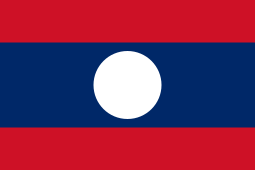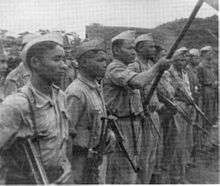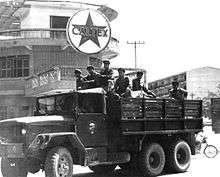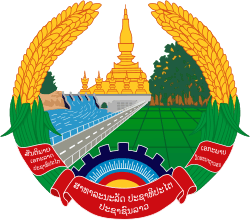Pathet Lao
The Pathet Lao (Lao: ປະເທດລາວ pa thēt lāo, "Lao Nation"[1]) was a communist political movement and organization in Laos, formed in the mid-20th century. The group was ultimately successful in assuming political power in 1975, after the Laotian Civil War. The Pathet Lao were always closely associated with Vietnamese communists. During the civil war, it was effectively organized, equipped and even led by the People's Army of Vietnam. They fought against the anti-communist forces in the Vietnam War. Eventually, the term became the generic name for Laotian communists.
| Pathet Lao | |
|---|---|
 Flag of the Pathet Lao | |
| Active | 1950 – 2 December 1975 |
| Ideology | Communism Marxism-Leninism Left-wing nationalism Pro-Vietnam |
| Leader | Prince Souphanouvong |
| Headquarters | Vientiane |
| Allies | State allies:
Non-state allies: |
| Opponent(s) | State opponents:
Non-state opponents: |
| Battles and war(s) | Indochina War Vietnam War Laotian Civil War Communist insurgency in Thailand |
Part of a series on the |
||||||||||||
|---|---|---|---|---|---|---|---|---|---|---|---|---|
| History of Laos | ||||||||||||
| Lan Xang Era | ||||||||||||
|
||||||||||||
| Regional Kingdoms Era | ||||||||||||
|
||||||||||||
| Colonial Era | ||||||||||||
|
||||||||||||
| Modern Era | ||||||||||||
|
||||||||||||
| See also | ||||||||||||
The most important source of military aid to the movement (as was also the case for the Vietnamese communists) was China; under orders from Mao Zedong, the People's Liberation Army provided 115,000 guns, 920,000 grenades and 170 million bullets, and trained more than 700 of its military officers.[2]
Organization
The political movement of the Pathet Lao was called first the "Lao People's Party" (1955–1972) and later the "Lao People's Revolutionary Party" (1972–present).
Key Pathet Lao leaders include Prince Souphanouvong, Kaysone Phomvihane, Phoumi Vongvichit, Nouhak Phoumsavanh and Khamtay Siphandone.
The political wing of the Pathet Lao, called the "Lao Patriotic Front" (Lao: Neo Lao Hak Xat) served in multiple coalition governments, starting in 1956. Through the 1960s and 1970s the Pathet Lao battled the Royal Lao government during the Laotian Civil War, gaining control of the north and east of Laos. The Pathet Lao gained power throughout the country by the spring of 1975. In December, the US-backed Vientiane government fell and the Lao People's Revolutionary Party formed a new government.[3]
History
40s & 50s
The organization can trace its roots from the Second World War, similar to the Khmer Issarak in Cambodia and the Viet Minh and Vietnam People's Army in Vietnam. Originally the Lao Issara, an anti-French, non-communist nationalist movement formed on October 12, 1945, it was renamed the "Pathet Lao" in 1950, when it was adopted by Lao forces under Souphanouvong, who joined the Viet Minh's revolt against the colonial French authorities in Indochina during the First Indochina War.
Souphanouvong, who had spent seven years in Nha Trang[4] during his sixteen years in Vietnam,[5] met Ho Chi Minh, married a Vietnamese woman while in Vietnam, and solicited Viet Minh aid in founding a guerrilla force.
In August 1950, Souphanouvong joined the Viet Minh in their headquarters north of Hanoi, Vietnam, and became the head of the Pathet Lao, along with its political arm dubbed "Neo Lao Issara" (Free Lao Front).[6] The Pathet Lao founded resistance government with members: Souphanouvong (prime minister, minister of the foreign), Kaysone Phomvihane (minister of the defence), Nouhak Phoumsavanh (minister of the economy), Phoumi Vongvichit (deputy prime minister, minister of the interior), Souk Vongsak, Sithon Kommadam, and Faydang Lobliayao. This was an attempt to give a false front of authority to the Lao communist movement by claiming to represent a united non-partisan effort. Two of its most important founders were members of the Indochinese Communist Party, which advocated an overthrow of the monarchy as well as expulsion of the French.[5]

In 1953, Pathet Lao fighters accompanied an invasion of Laos from Vietnam led by Viet Minh forces; they established a government at Viengxay in Houaphan province in northeast Laos. The communists began to make incursions into central Laos with the support of the Viet Minh, and a civil war erupted; the Pathet Lao quickly occupied substantial sections of the country.
The 1954 Geneva Conference agreements required the withdrawal of foreign forces, and allowed the Pathet Lao to establish itself as a regime in Laos's two northern provinces. The Viet Minh and North Vietnamese, in spite of the agreement, never really withdrew from the border areas of Laos, and the Pathet Lao continued to operate almost as a branch organization of the Viet Minh. Two months after the conference, the Viet Minh-North Vietnamese formed the unit Group 100 with headquarters at Ban Nameo. The unit effectively controlled and directed the Pathet Lao movement.
It was formed into an official party, the Lao Patriotic Front (Neo Lao Hak Sat), in 1956. Its stated goal was to wage the communist struggle against capitalism and Western colonialism and imperialism. Unstated was its subordination to the Communist Party of Vietnam. A coalition government was established in 1957 between the monarchists and communists, but it collapsed in 1959, bringing about a resumption of fighting.
By the late 1950s, North Vietnam had occupied areas of eastern Laos. The area was used as a transit route for men and supplies destined for the insurgency in South Vietnam. In September 1959, North Vietnam formed Group 959 in Laos with the aim of building the Pathet Lao into a stronger counterforce against the Lao Royal government. Group 959 openly supplied, trained and militarily supported the Pathet Lao. The typical strategy during this era was for North Vietnamese regulars to attack first but then send in the Pathet Lao at the end of the battle to claim victory.
1960s and 1970s
In the 1960s, more attempts at neutrality agreements and coalition government were attempted but as North Vietnam had no intention of withdrawing from Laos, these agreements all failed. By the mid-1960s, the country had fallen into proxy warfare between pro-US and pro-Vietnamese irregular military groups. In 1968, the Army of North Vietnam launched a multi-division invasion of Laos. The Pathet Lao were pushed to the side in the conflict and reduced to the role of an auxiliary force to the North Vietnamese army. Unable to match the heavy Soviet and Chinese weapons in addition to the numerical strength of the Vietnamese forces, the Royal Lao Army took itself out of the conflict after heavy losses.
The communist forces battled the Royal Lao Army, US irregular forces (including Air America and other contract employees and Hmong commandos), and Thai volunteer forces in Laos winning effective control in the north and east. The government itself was effectively powerless. The Pathet Lao held hundreds of US "detainees" as prisoners of war during and after the Vietnam War (Second Indochina War).

Shortly after the Paris Peace Accords ended US involvement in the Vietnam War, the Pathet Lao and the government of Laos signed a cease-fire agreement, the Vientiane Treaty, in February 1973.[7]
In December 1974, they were responsible for the killing of Charles Dean and Neil Sharman.
The coalition government envisaged by the treaty lasted only two years. The Pathet Lao refused to disarm and the North Vietnamese Army did not leave the country. In late May 1975, the Pathet Lao, with the direct assistance of the North Vietnamese Army, began attacking government strongholds. With the fall of the South Vietnamese government to the North Vietnamese on 30 April 1975 and the fall of the Cambodian government to the Khmer Rouge on April 17, the non-communist elements of the national government decided that allowing the Pathet Lao to enter power would be better than to have them take it by force. On 23 August 1975, Pathet Lao forces quietly entered the Lao capital city of Vientiane.
On 2 December 1975, the Pathet Lao firmly took over the government, abolishing the monarchy and establishing the Lao People's Democratic Republic. Shortly thereafter, the Pathet Lao signed an agreement with Vietnam that allowed Vietnam to station part of its army in the country and to send political and economic advisors into Laos. Vietnam afterward forced Laos to cut any remaining economic ties to its other neighbours, including Thailand and Cambodia.
After the Pathet Lao took over the country in 1975, the conflict continued in isolated pockets. In 1977, a communist newspaper promised the party would hunt down the "American collaborators" and their families "to the last root". With the demise of the Soviet Union, control of Laos by Vietnam waned at the end of the 1980s. Today, "Pathet Lao" is often invoked as a general term signifying Lao nationalism.
See also
- Indochina
- Laotian Civil War (the Secret War)
- Vietnam War
- Lao People's Revolutionary Party
References
- Andrea Matles Savada, ed. (1994). "The Pathet Lao". Laos: A Country Study. GPO for the Library of Congress. Retrieved August 8, 2011.
.... The basic stance of this front's propaganda was the united struggle against the French without reference to political parties or ideology. Illustrative of this stance was the use henceforth of the name Pathet Lao (Lao Nation).
CS1 maint: extra text: authors list (link) - Brazinsky, Gregg A. (2017) Winning the Third World: Sino-American Rivalry during the Cold War, p. 249, The University of North Carolina Press
- "Pathet Lao". britannica. Retrieved 9 March 2013.
- At War in the Shadow of Vietnam: U. S. Military Aid to the Royal Lao Government, 1955 - 1975. p. 7.
- Laos: The Pathet Lao Library of Congress Country Studies
- At War in the Shadow of Vietnam: U. S. Military Aid to the Royal Lao Government, 1955 - 1975. pp. 7, 142–143.
- Stalker, John N. (1974). "Laos". The World Book Year Book 1974. Chicago: Field Enterprises Educational Corporation. p. 375. ISBN 0-7166-0474-4. LCCN 62-4818.
Further reading
- Evans, Grant (2002). A Short History of Laos: The Land in Between. Allen & Unwin. ISBN 9781864489972. Retrieved 17 October 2019.
External links
- https://web.archive.org/web/20120204034101/http://www.onwar.com/aced/data/lima/laos1962.htm
- https://web.archive.org/web/20120204034105/http://www.onwar.com/aced/data/lima/laos1954.htm
- http://www.factmonster.com/ce6/world/A0859186.html
- http://countrystudies.us/laos/
- http://countrystudies.us/laos/14.htm
- http://www.britannica.com/eb/article-9058717/Pathet-Lao
